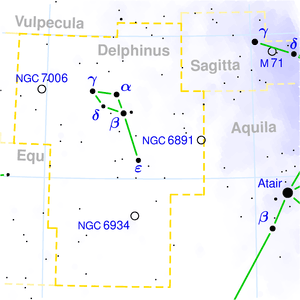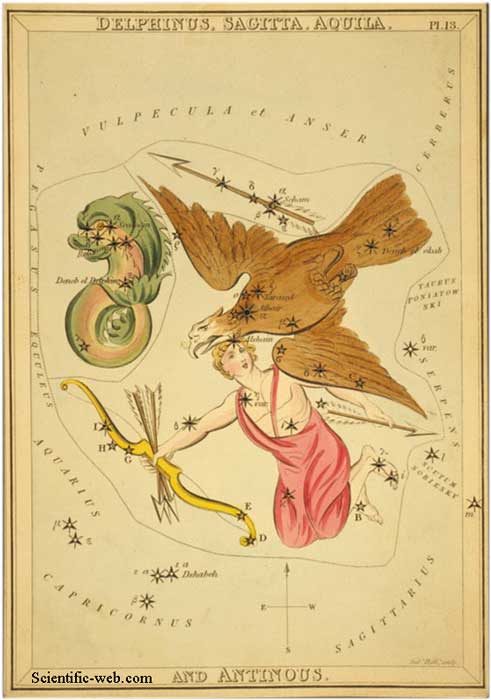
|
Delphinus ( Latin: dolphin), is a rather small (ranked 69th) northern constellation very close to the celestial equator. It was already included in Ptolemy's list of 48 constellations and also forms part of the modern list of 88 constellations approved by the IAU. It looks remarkably like a leaping dolphin and thus can easily be recognized in the sky. Delphinus is surrounded (clockwise from north) by the little fox Vulpecula, the flying arrow Sagitta, the eagle Aquila, the water carrier Aquarius, the little horse Equuleus and finally the flying horse Pegasus. Notable features Here are some of its stars: * α Del (Sualocin): B9 IV, 3.77m (multiple star system with 6 components) * β Del (Rotanev): F5 IV, 4m - 4.9 m * γ Del: one of the finest double stars in the sky. o γ1 Del: F7 V, 5.14m o γ² Del: K1 IV, 4.27m * δ Del: A7 IIIp, 4.43m * The above mentioned stars form an asterism called Job's Coffin. * ε Del (Deneb Dulfim, or the tail of the Dolphin) is a star of spectral class B6 III with a magnitude of 4 * R Del: Mira-type variable star with a period of 285.5 days; magnitude range between 7.6 and 13.8 Notable deep sky objects * NGC 6891: Planetary nebula; 10.5m * NGC 6934: This globular cluster is of magnitude 9.75 * NGC 7006: at a distance of about 185,000 light-years this globular cluster is extremely remote; 11.5m History The names of the two brightest stars of this constellation, Sualocin (Alpha Delphini) and Rotanev (Beta Delphini), are not, as one might expect, names dating from Antiquity, but instead are quite new. They first appeared in a star catalogue of 1814 that was published at the Palermo Observatory in Italy. When read backwards they form the name Nicolaus Venator which is the Latinized version of the name of the assistant director of that observatory at that time: Niccolò Cacciatore (both Cacciatore and Venator mean hunter). Mythology There are two major stories from Greek mythology behind this constellation. According to the first one, Greek god Poseidon wanted to marry Amphitrite, a nereid. She, however, wanting to protect her virginity, fled to the Atlas mountains. Her suitor then sent out several searchers, among them a certain Delphinus. Delphinus accidentally stumbled upon her and was able to persuade Amphitrite to accept Poseidon's wooing. Out of gratitude the god placed the image of a dolphin among the stars. The second story tells of the Greek poet Arion of Lesbos (7th century BC), a court musician at the palace of Periander, ruler of Corinth. Arion had amassed a fortune during his travels to Sicily and Italy. On his way home from Tarentum his wealth caused the crew of his ship to conspire against him. Threatened with death, Arion asked to be granted a last wish which the crew granted: he wanted to sing a dirge. This he did and while doing so flung himself into the Sea from where he was rescued by a dolphin which had been charmed by Arion's music. The dolphin carried Arion to the coast of Greece and left.
Delphinus, Sagitta, Aquila, and Antinous References * Ian Ridpath and Wil Tirion (2007). Stars and Planets Guide Links * The Deep Photographic Guide to the Constellations: Delphinus
Retrieved from "http://en.wikipedia.org/"
|
|
||||||||||||||||||||||||||||||||||||||||||||||||||||

